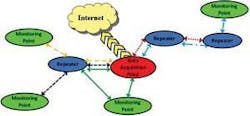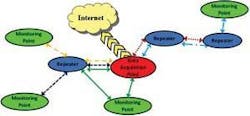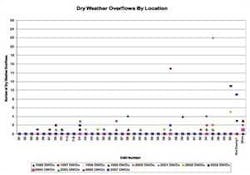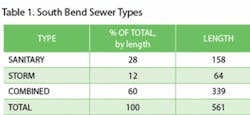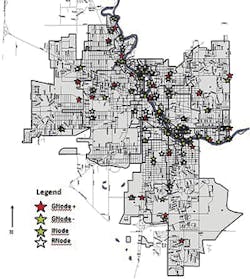CSO Monitoring Using an Embedded Sensor Network
by Timothy Ruggaber, Gregory Garnes, Gregory Osthues, Richard Radcliff
Combined sewer overflow (CSO) events are responsible for the release of 850 billion gallons of untreated wastewater annually into the United States' lakes and rivers, as well as countless basement floodings. In 1994, the United States Environmental Protection Agency mandated that all CSO communities must drastically reduce the number and severity of their CSO events.
It is widely acknowledged that extensive monitoring is the best way to determine a system's hydraulics, and an embedded sensor network is perfectly suited for such a deployment because it is easy to install, wireless, battery-powered, incrementally implementable, and decentralized (i.e., requires no central computing center).
Such a monitoring system takes the guesswork out of hydraulic modeling and allows a municipality to understand what is happening throughout the sewer system during every storm event. With this data, municipalities can determine areas that are at high risk for basement backups, areas with blockages or excessive inflow and infiltration, and areas that are under-utilized (and therefore, potential areas for inline storage). The municipality can then pinpoint and solve infrastructure problems easily and accurately.
Explanation of CSOnet Concept
The goal of CSOnet is to maximize the use of the existing infrastructure and minimize future construction through the use of real-time monitoring and control. A real-time monitoring system can be implemented in either a centralized fashion or in a decentralized fashion. The more traditional centralized method utilizes programmable logic controllers (PLCs) to collect data from sensors installed in the sewer, which then send the data to a centralized computing center through a SCADA system. Such a system requires a large amount of equipment (such as a power cabinet, directional antenna, high powered radio, antenna pole, a PLC, etc.) to be installed at each monitoring location. All of this equipment makes the installation of a monitoring point expensive and labor intensive and limits both the number of monitoring sites in a municipality and a municipality's flexibility in monitoring site selection.
On the other hand, CSOnet is a decentralized system. It utilizes several data acquisition points deployed throughout a municipality, each of which collects data from the surrounding monitoring points and uploads it to a secure website on the Internet. Because each monitoring point does not have to send its data as far, it doesn't require high power radios, a large amount of bandwidth, or a constant external power source to power the radio. A small, battery powered microcontroller collects the data from the sensor and sends it to the data acquisition point via a low-power radio. By using a decentralized approach, the complexity of the system and the amount of equipment needed at each location is greatly reduced, making the system easier and less expensive to install and operate.
Each data acquisition point and its surrounding monitoring points form a unique network of sensors and nodes called a subnet (see Fig 1). Every five minutes, the data acquisition point collects all of the data from the surrounding monitoring points. This collection can be either through direct radio communication, or if the distance between the data acquisition point and the monitoring is farther than the range of the radio, through one or more repeaters, which relay the data from the monitoring point to the data acquisition point. After all of the data is collected, the data acquisition point uploads it to a secure website. Additional monitoring points can easily be added to the subnet, requiring only minimal changes to the rest of the subnet.
The South Bend Combined Sewer System
The city of South Bend, IN, is currently working with EmNet, LLC to implement a citywide embedded sensor network to monitor its combined sewer system (CSS). In addition to monitoring South Bend’s 36 outfalls, this network also monitors flows and depths throughout its 7-mile-long interceptor, in all major trunklines throughout its 13,100 acre CSS, and in five retention basins. Upon its completion, the network will monitor 110 locations. All of the data that the network gathers is then posted onto a secure website in real time and archived for later analysis.
Like many Midwestern cities, South Bend's sewer system was built as a combined system. As one of the compliance measures selected for the Long Term Control Plan (LTCP), the city has been actively separating the combined system. Table 1 details the percentage and length of sewer types in South Bend.
The city of South Bend has a combined sewer service area of 13,100 acres comprised of approximately 80% combined sewers and 20% separate sewers by coverage area, which serves the incorporated area of South Bend and a portion of adjoining Clay Township. As a part of the sewer system, South Bend has 36 permitted CSO outfalls. Some of the CSOs lie at elevations that are below the normal river elevation. Backwater gates have been installed at these sites. However, despite the presence of the backwater gates, several sites still have significant inflows.
Wet Weather and Dry Weather Overflows
Wet weather discharges are currently legal; however, the U.S. EPA is working with the city to implement a LTCP that would limit the volume of wet weather discharges from the CSO system. While wet weather discharges are currently legal, dry weather overflows are not.
Dry weather overflows are tracked on a monthly and annual basis (see Fig. 2), and certain sites, designated as "hot spots," have a greater incidence of dry weather overflows than others. Hot spots are inspected every Monday and 24 hours after any wet weather event. One of the main reasons that South Bend wants to monitor its sewer system is so that it can actively prevent these dry weather overflows without needing to send a crew out to inspect all of these sites over a hundred times a year.
The CSOnet system network consists of 110 monitoring locations. The monitoring location devices include four area-velocity meters with the remainder being pressure transducers. The monitoring locations throughout the system include the following:
- 36 CSO structures with installed pressure sensors
- 27 interceptor sewers downstream of the CSO structures
- 42 trunkline sewer monitoring points upstream of the CSO structures
- 5 basin storage locations
In total, 149 nodes are needed in order to monitor all of these sites (see Fig. 3).
Current Status of the CSOnet System and Future Work
The system started collecting data as soon as the first node was installed. The data is continually being uploaded to the secure website (see Fig. 4), where it is being analyzed to determine where and how the real-time control should be implemented. Work on the real-time control phase of the CSOnet project is expected begin in Fall 2008.
Once a sufficient amount of data has been gathered and analyzed, the control sites will be selected and construction will begin. The CSOnet system itself will not have to change in any significant way to transfer from only monitoring to monitoring and controlling the sewer flows, since the GNodes are all installed and ready to control valves. CSOnet will pursue two different aspects of real-time control: maximization of flow to the wastewater treatment plant (WWTP) and online/offline storage.
Summary
CSOnet is a comprehensive system for the real-time monitoring and control of combined sewer systems. In South Bend, data from CSOnet will be used to further calibrate its SWMM model, report CSO events to the regulatory agencies, proactively prevent dry weather overflows and sewer problems, and most importantly, determine at which locations real-time control will be implemented.
About the Authors:
Timothy Ruggaber is Director of Operations for EmNet, LLC (Granger, IN). Gregory Garnes, P.E., is Senior Project Engineer with Malcolm Pirnie, Inc. (Indianapolis, IN). Gregory Osthues, P.E., is a Senior Associate with Malcolm Pirnie, Inc. (Akron, OH). Richard Radcliff is CSO Operations Manager for the Division of Environmental Services, City of South Bend.
